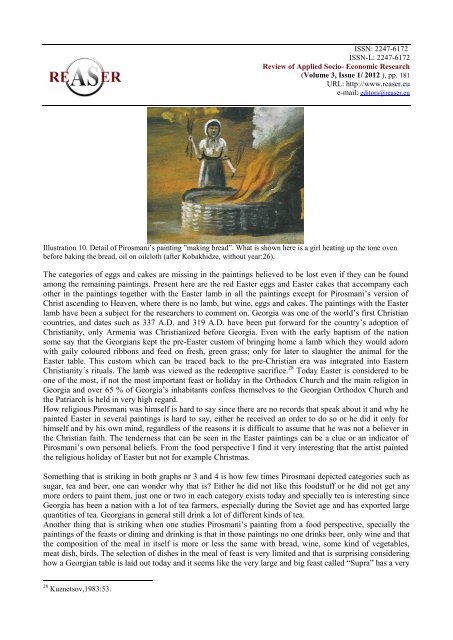Volume 3, ISSUE1/2012 - Review of Applied Socio-Economic ...
Volume 3, ISSUE1/2012 - Review of Applied Socio-Economic ...
Volume 3, ISSUE1/2012 - Review of Applied Socio-Economic ...
Create successful ePaper yourself
Turn your PDF publications into a flip-book with our unique Google optimized e-Paper software.
ISSN: 2247-6172<br />
ISSN-L: 2247-6172<br />
<strong>Review</strong> <strong>of</strong> <strong>Applied</strong> <strong>Socio</strong>- <strong>Economic</strong> Research<br />
(<strong>Volume</strong> 3, Issue 1/ <strong>2012</strong> ), pp. 181<br />
URL: http://www.reaser.eu<br />
e-mail: editors@reaser.eu<br />
Illustration 10. Detail <strong>of</strong> Pirosmani’s painting ”making bread”. What is shown here is a girl heating up the tone oven<br />
before baking the bread, oil on oilcloth (after Kobakhidze, without year:26).<br />
The categories <strong>of</strong> eggs and cakes are missing in the paintings believed to be lost even if they can be found<br />
among the remaining paintings. Present here are the red Easter eggs and Easter cakes that accompany each<br />
other in the paintings together with the Easter lamb in all the paintings except for Pirosmani’s version <strong>of</strong><br />
Christ ascending to Heaven, where there is no lamb, but wine, eggs and cakes. The paintings with the Easter<br />
lamb have been a subject for the researchers to comment on. Georgia was one <strong>of</strong> the world’s first Christian<br />
countries, and dates such as 337 A.D. and 319 A.D. have been put forward for the country’s adoption <strong>of</strong><br />
Christianity, only Armenia was Christianized before Georgia. Even with the early baptism <strong>of</strong> the nation<br />
some say that the Georgians kept the pre-Easter custom <strong>of</strong> bringing home a lamb which they would adorn<br />
with gaily coloured ribbons and feed on fresh, green grass; only for later to slaughter the animal for the<br />
Easter table. This custom which can be traced back to the pre-Christian era was integrated into Eastern<br />
Christianity´s rituals. The lamb was viewed as the redemptive sacrifice. 28 Today Easter is considered to be<br />
one <strong>of</strong> the most, if not the most important feast or holiday in the Orthodox Church and the main religion in<br />
Georgia and over 65 % <strong>of</strong> Georgia’s inhabitants confess themselves to the Georgian Orthodox Church and<br />
the Patriarch is held in very high regard.<br />
How religious Pirosmani was himself is hard to say since there are no records that speak about it and why he<br />
painted Easter in several paintings is hard to say, either he received an order to do so or he did it only for<br />
himself and by his own mind, regardless <strong>of</strong> the reasons it is difficult to assume that he was not a believer in<br />
the Christian faith. The tenderness that can be seen in the Easter paintings can be a clue or an indicator <strong>of</strong><br />
Pirosmani’s own personal beliefs. From the food perspective I find it very interesting that the artist painted<br />
the religious holiday <strong>of</strong> Easter but not for example Christmas.<br />
Something that is striking in both graphs nr 3 and 4 is how few times Pirosmani depicted categories such as<br />
sugar, tea and beer, one can wonder why that is? Either he did not like this foodstuff or he did not get any<br />
more orders to paint them, just one or two in each category exists today and specially tea is interesting since<br />
Georgia has been a nation with a lot <strong>of</strong> tea farmers, especially during the Soviet age and has exported large<br />
quantities <strong>of</strong> tea. Georgians in general still drink a lot <strong>of</strong> different kinds <strong>of</strong> tea.<br />
Another thing that is striking when one studies Pirosmani’s painting from a food perspective, specially the<br />
paintings <strong>of</strong> the feasts or dining and drinking is that in those paintings no one drinks beer, only wine and that<br />
the composition <strong>of</strong> the meal in itself is more or less the same with bread, wine, some kind <strong>of</strong> vegetables,<br />
meat dish, birds. The selection <strong>of</strong> dishes in the meal <strong>of</strong> feast is very limited and that is surprising considering<br />
how a Georgian table is laid out today and it seems like the very large and big feast called “Supra” has a very<br />
28 Kuznetsov,1983:53.








